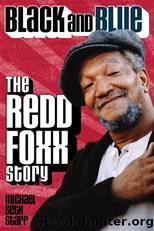Black and Blue: The Redd Foxx Story by Michael Seth Starr

Author:Michael Seth Starr
Language: eng
Format: epub
Published: 2016-08-28T16:00:00+00:00
chapter ten
“The Way It Is, I’m Still in Slavery”
Sanford and Son ended its second season on March 16, 1973, as the second-most-popular show on television. NBC’s juggernaut sitcom averaged nearly eighteen million viewers a week for the season, four million viewers behind first-place All in the Family but a comfortable two million viewers more than third-place Hawaii Five-O. Programming executives at the competing networks, including then-CBS programming chief Fred Silverman, tried everything they could think of to make a dent in Sanford and Son’s viewing audience. Nothing worked. America, it seemed, just loved Fred Sanford too much.
“1That show was monstrous,” Silverman said. “The combination of Sanford and Son and Chico and the Man [at NBC] ... it was probably the most successful period in the history of network television, and that one hour from eight to nine o’clock was the bane of my existence. It was like a brick wall. There was nothing we could put against it. We tried everything.” Over the course of Sanford and Son’s run, Silverman tried counter-programming several sitcoms to steal some of its thunder, including Dirty Sally, starring Jeannette Nolan, and Colucci’s Department, starring James Coco. Both shows failed. Dramas didn’t work either; a Planet of the Apes series, spun off front the popular big-screen movie series, bombed, as did Khan!, a private-eye series starring Khigh Dhiegh, who played Wo Fat on Hawaii Five-O. “2There was a show Larry Gelbart wrote called Roll Out which was kind of a half-assed spin-off of M*A *S*H ... so I’m not exaggerating when I say we must have put a dozen shows in that time period at CBS,” Silverman said. “Nothing worked against Sanford and Son. It was just incredible.”
In only two years on the air, Fred Sanford had morphed into a cultural institution. His chest-clutching antics (“Ya hear that Elizabeth? It’s the Big One! I’m comin’ to join ya, honey!”) and his verbal battles with Aunt Esther (“I could stick your face in some dough and make some gorilla cookies!) were parts of the pop-culture landscape. And now Redd was reaping the rewards of his “overnight” ascent into the limelight. He was the focus of many magazine and newspaper features, which usually recounted his by-now-familiar story (struggling street performer works the Chitlin’ Circuit, becomes “King of the Party Records” then hits it big on television) and he was generally credited with being the main reason for Sanford and Son’s success.
“3We probably don’t have more than a couple of clowns in a century, and Redd Foxx was a clown,” said Norman Lear, the show’s co-creator. “I know he was considered a comedian. But the difference between a comedian and a clown, in my estimation, is that every square inch of a clown is funny. His knuckles are funny, his earlobes are funny; Redd could walk into a room and announce that your mother had died and get a laugh from you. He was inherently, innately funny in every part of his being. So we fell in love with that.
Download
This site does not store any files on its server. We only index and link to content provided by other sites. Please contact the content providers to delete copyright contents if any and email us, we'll remove relevant links or contents immediately.
| Dance | Individual Directors |
| Magic & Illusion | Reference |
| Theater |
Call Me by Your Name by André Aciman(18967)
Ready Player One by Cline Ernest(12839)
How to Be a Bawse: A Guide to Conquering Life by Lilly Singh(6693)
Wiseguy by Nicholas Pileggi(4586)
The Kite Runner by Khaled Hosseini(4436)
On Writing A Memoir of the Craft by Stephen King(4214)
The Crown by Robert Lacey(4105)
Audition by Ryu Murakami(4099)
Call me by your name by Andre Aciman(4073)
Harry Potter and the Cursed Child: The Journey by Harry Potter Theatrical Productions(3965)
Gerald's Game by Stephen King(3918)
The Perils of Being Moderately Famous by Soha Ali Khan(3783)
Dialogue by Robert McKee(3582)
Dynamic Alignment Through Imagery by Eric Franklin(3489)
Apollo 8 by Jeffrey Kluger(3200)
How to be Champion: My Autobiography by Sarah Millican(3186)
Seriously... I'm Kidding by Ellen DeGeneres(3100)
Darker by E L James(3088)
History of Dance, 2E by Gayle Kassing(3000)
